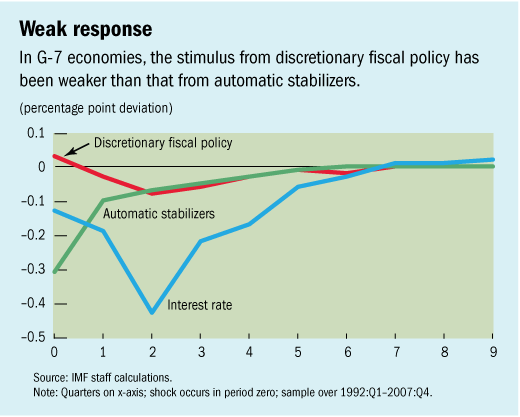
Typical street scene in Santa Ana, El Salvador. (Photo: iStock)
IMF Survey: Making Fiscal Stimulus Effective During Downturns
October 2, 2008
- Fiscal stimulus is a potential tool for countering economic slowdowns
- But it needs to be timely, targeted, and temporary for it to be effective
- Automatic stabilizers could be made more effective against downturns
A new IMF study finds that although fiscal policy is a potentially valuable tool for stimulating growth, it can easily do more harm than good if it is not implemented well.

In emerging economies, stimulus added during good times and removed during downturns has tended to destabilize (photo: Bay Ismoyo/AFP)
POLICY RESPONSES TO SLOWDOWNS
Tax cuts or spending increases that make debt unsustainable are likely to cause output to fall, not rise.
The study, published in the October 2008 World Economic Outlook, shows that a key challenge to policymakers is to make sure that discretionary fiscal policy measures—that is, changes in spending and taxation—are delivered quickly and that they do not cause concerns about future debt sustainability.
In practice, discretionary fiscal measures are typically slower to arrive than monetary policy responses, which entail changes in interest rates or exchange rate targets, and the effects of automatic stabilizers—changes in spending and taxes that happen naturally as the economy fluctuates, such as increases in spending on unemployment benefits during downturns. Moreover, fiscal measures often become permanent, implying that public debt creeps upward.
The study finds that discretionary fiscal policy can have moderately countercyclical effects in advanced economies. But stimulus packages are typically less successful in emerging economies—possibly because of concerns about the implications of higher debt for taxes, spending, and inflation in the future.
Role of fiscal policy
Recent months have seen economies buffeted by falling asset prices, rising costs of raw materials and credit, and reduced confidence. In response, there have been calls in many countries for governments to actively use fiscal policy to stimulate the economy. Indeed, the United States has already responded with the Economic Stimulus Act, passed in February 2008. But there are many commentators and economists who argue that these sorts of actions stand to do more harm than good. Against the background of this debate and the recent turmoil in world markets, Chapter 5 of the World Economic Outlook, entitled "Fiscal Policy as a Countercyclical Tool," takes a fresh look at the role of fiscal policy during economic downturns.
Responding to business cycle changes
One of the first questions that policymakers need to address is whether discretionary fiscal policy can be delivered on time and delivered well. We summarize this in terms of three "Ts": timely, targeted, and temporary. History tells us that it has usually proven a challenge to meet these criteria: discretionary fiscal policy has usually been used less frequently than monetary policy during downturns, and it has taken longer to arrive─often after it is needed.
Also the response is typically weaker than the stimulus provided by automatic stabilizers (see chart). Moreover, discretionary policy typically shows an easing bias—taxes are cut and spending raised by more during downturns than taxes raised and spending cut during upturns. This means that debt typically creeps upward. By contrast, a clear advantage of automatic stabilizers is that they respond symmetrically over the cycle.

Another important question is: Have governments in emerging economies applied fiscal policy differently than those in advanced economies? Yes: in advanced economies, discretionary fiscal policy has typically been countercyclical—that is, taxes have been cut and spending increased during downturns. In emerging economies, it has been procyclical—that is, stimulus has been added during good times and removed during downturns. This suggests that fiscal policy has typically tended to destabilize emerging economies rather than reduce fluctuations.
Effects on economic activity
New evidence presented in the chapter finds that discretionary fiscal policy can have moderately countercyclical effects—but that there are also important caveats. The results indicate that effects of discretionary fiscal policy are different between advanced and emerging economies.
On average, for all economies, a discretionary stimulus package equivalent to 1 percent of country's GDP is associated with GDP increases of about 0.1 to 0.2 percent. In advanced economies, the longer-term effects are also positive and even possibly higher. But the longer-term effects are typically negative in emerging economies.
What is behind this? The chapter looks at a number of factors, such as exchange rate regimes and trade openness, and finds that debt sustainability concerns may play a key role—domestic households and firms may anticipate higher taxes or inflation in the future, and international capital markets may impose higher interest rates to insure against these risks. The result is that households will save more, reducing demand for goods and services, and firms will be less able to invest in equipment and stock.
Making fiscal policy more effective
So what can governments do if they want to employ discretionary fiscal policy measures? They need to ensure that they improve fiscal positions during good times and credibly commit that stimulus packages are temporary.
The composition of fiscal packages also matters: policy changes based on cutting taxes appear to be more successful at stimulating growth than those based on increased spending. And fiscal policy changes need to be coordinated with monetary policy goals—increased spending, in particular, can create pressure on prices.
Given the problems that we see with discretionary fiscal policy, one implication is that governments could try to enhance the scope and effectiveness of automatic stabilizers.
Immediate response
Automatic stabilizers respond immediately and symmetrically—tax revenues rise by just as much as output rises as they fall with output—to business cycle fluctuations. This means that they have a natural advantage over discretionary policy, in that public debt automatically remains stable over the business cycle. But automatic stabilizers are typically by-products of longer-term social objectives rather than being designed deliberately to counter business cycle fluctuations.
Instead, policymakers could examine whether automatic stabilizers could be designed to have stronger stabilization effects. For example, tax, transfer, or spending programs could be linked directly to the state of the economy.
Another possibility is to bolster the credibility of discretionary measures, with the aim of reducing debt bias, by changes in fiscal governance—in particular, by placing more emphasis on transparent evaluations of the state of the economy and longer-term implications of fiscal measures.
Comments on this article should be sent to imfsurvey@imf.org







